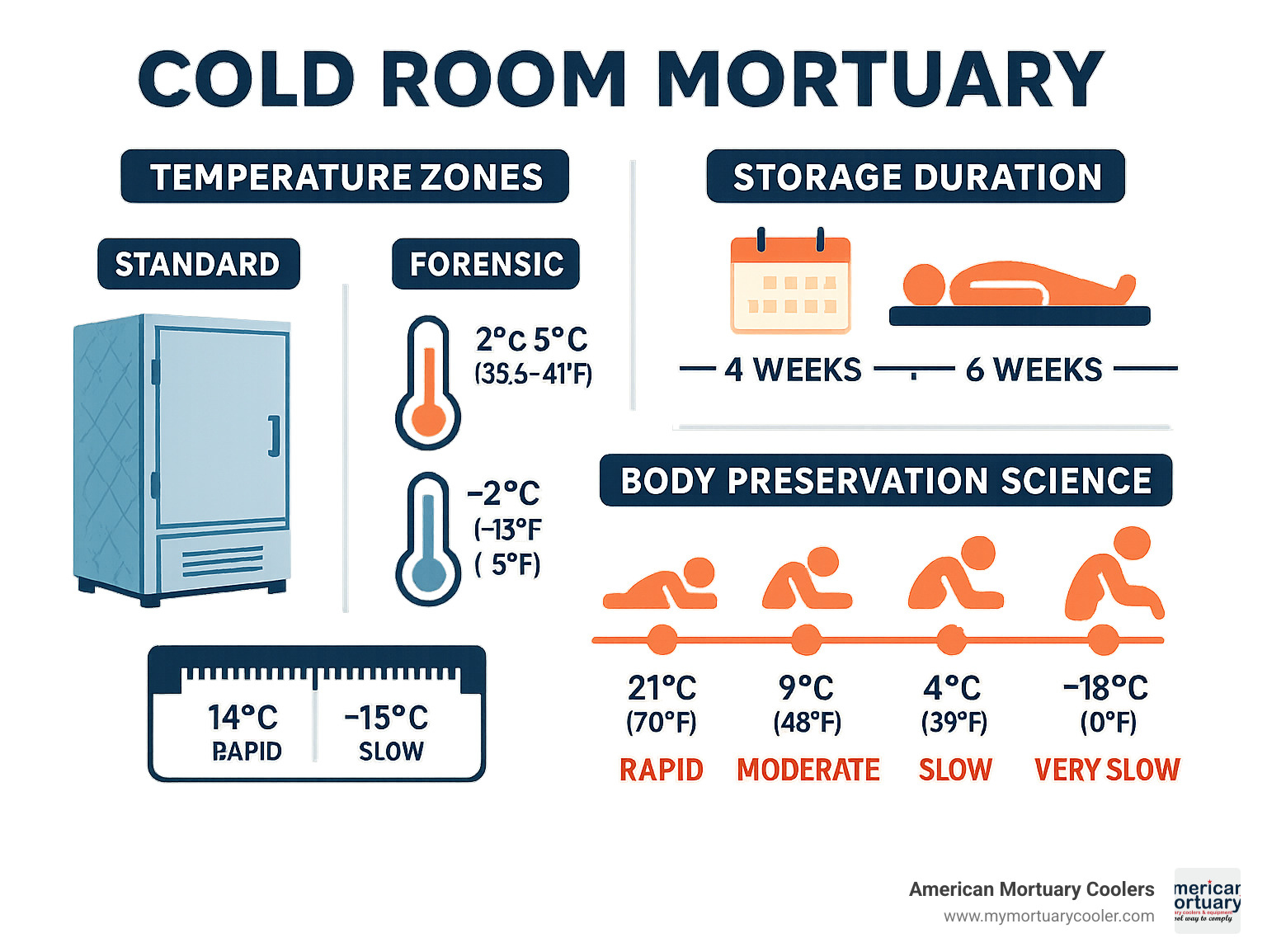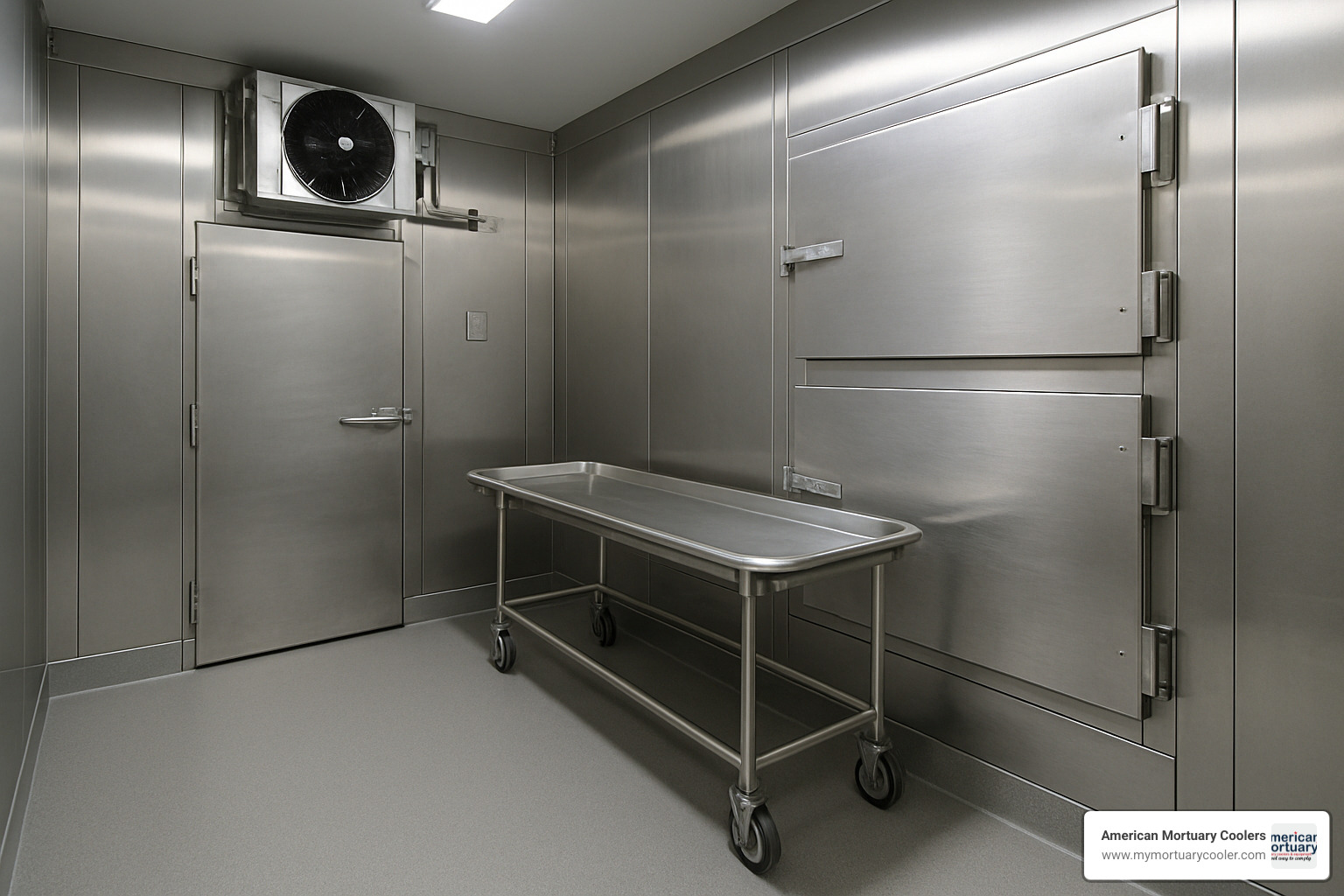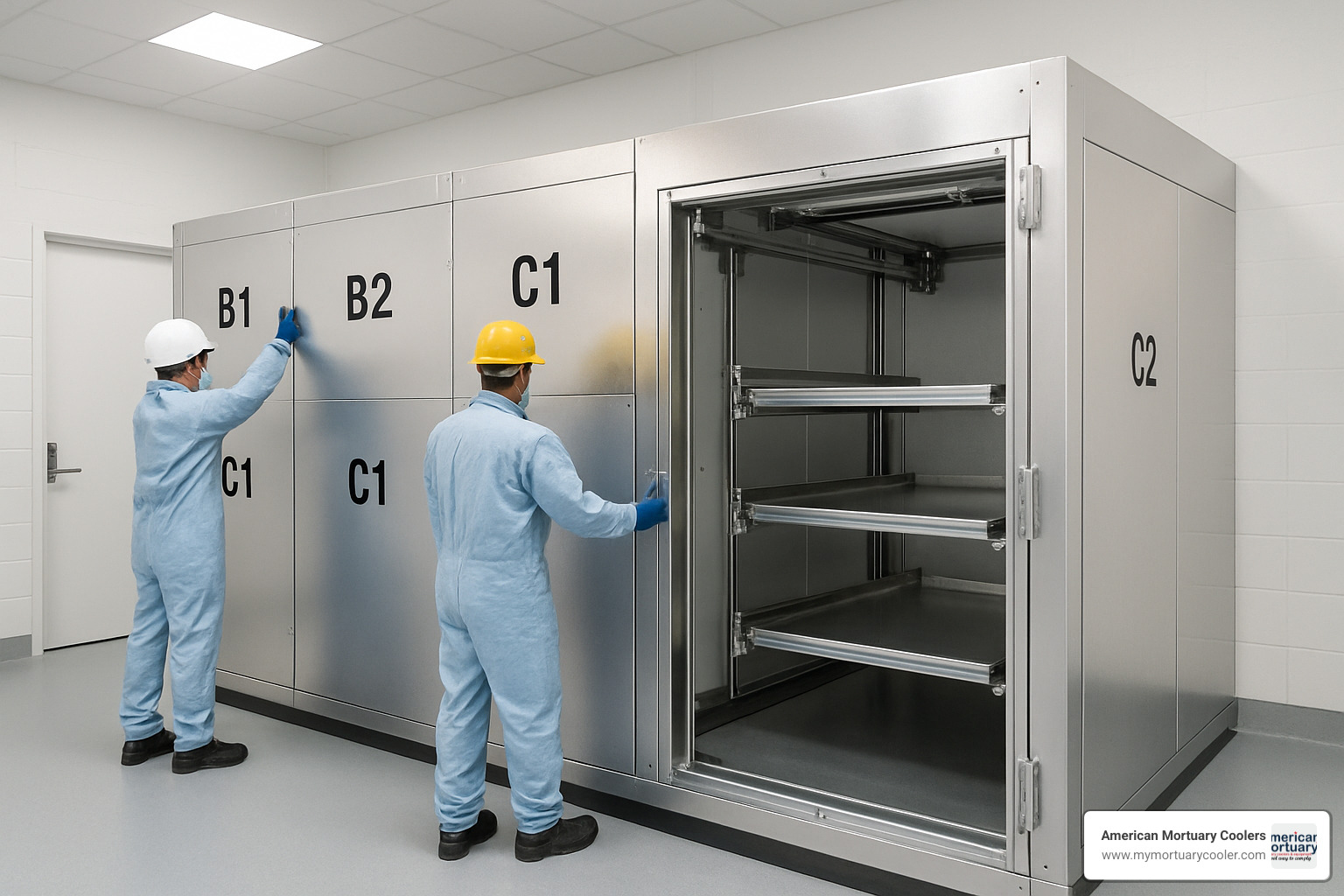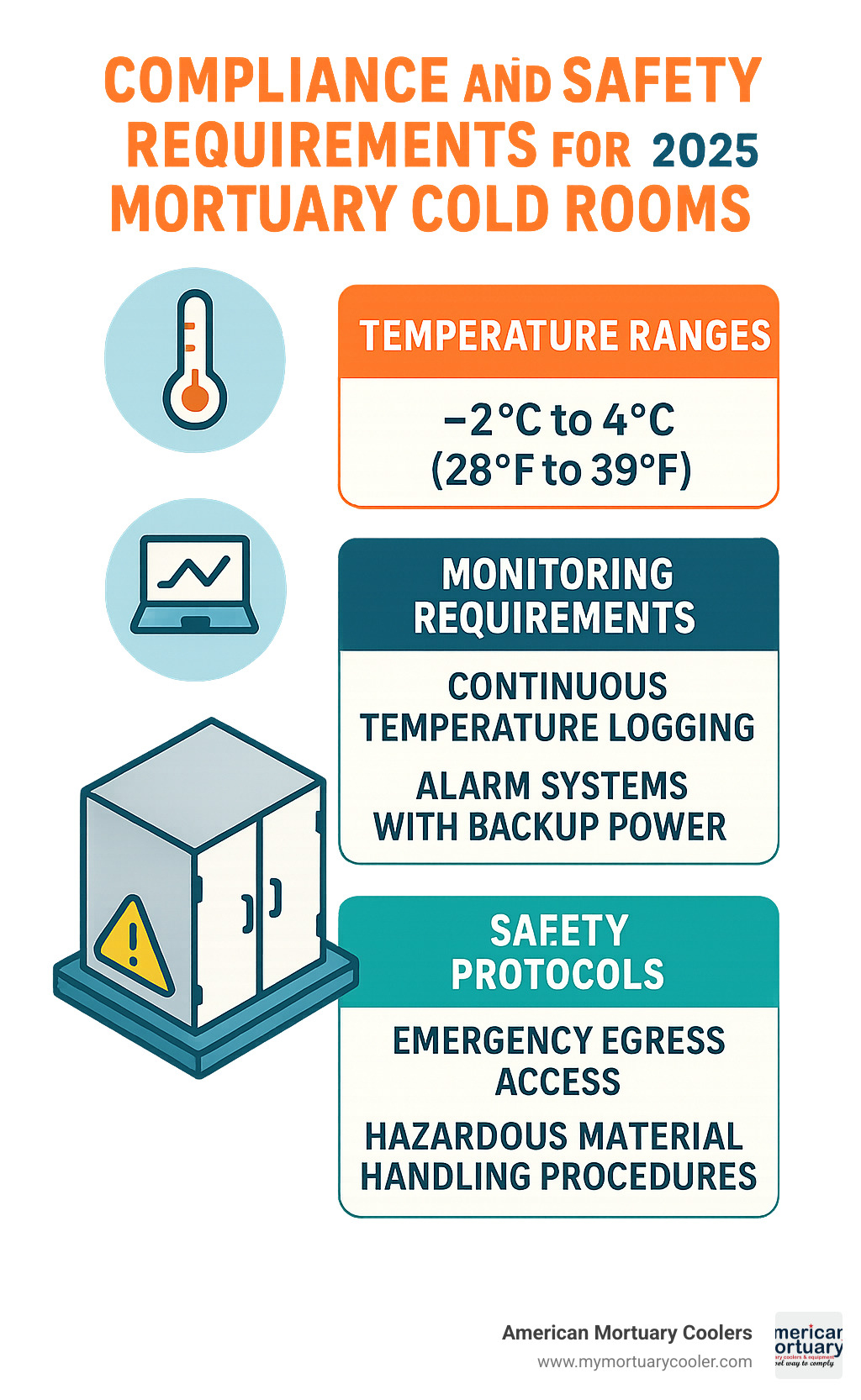
Detailed Guide to Finding the Right Mortuary Cold Room
Why Cold Room Mortuary Systems Are Essential for Modern Funeral Care
A cold room mortuary is a specialized refrigerated facility designed to store deceased bodies at controlled temperatures between 2°C and 5°C (35.6°F to 41°F) to slow decomposition and preserve remains with dignity. These systems serve as the backbone of funeral homes, hospitals, and morgues worldwide.
Quick Facts About Cold Room Mortuary Systems:
- Temperature Range: 2°C to 5°C for standard preservation, -15°C to -25°C for forensic storage
- Storage Duration: Bodies can be preserved for 4-6 weeks under proper conditions
- Types Available: Walk-in rooms, modular panels, mobile units, and cabinet systems
- Key Benefits: Eliminates chemical preservatives, provides eco-friendly storage, accommodates cultural timing requirements
Modern funeral care has evolved beyond traditional embalming methods. Cold rooms offer a greener alternative to chemical preservation while providing families the time they need to grieve and plan services.
These refrigerated storage systems are mandatory in many regions for cities with populations over 5,000 inhabitants. They're essential for routine operations, surge capacity during emergencies, and forensic investigations where evidence preservation is critical.

Cold room mortuary terminology:
What Is a Cold Room Mortuary and Why It Matters
A cold room mortuary is a specialized refrigerated space designed to preserve human remains with dignity while giving families the time they need. These systems work by maintaining precise temperatures between 2°C and 4°C (about 35°F to 39°F) to slow the natural decomposition process.
Scientific research on corpse refrigeration shows that this temperature range can preserve remains for four to six weeks under proper conditions. Compare that to just hours at room temperature, and you can see why these systems have become essential.
Morgues typically operate in hospitals or forensic facilities, focusing on temporary storage and autopsy work. Mortuaries are part of funeral homes, where the emphasis is on preparing bodies for services and helping families. Both need cold storage, but their daily operations differ significantly.
How a cold room mortuary differs from traditional storage
While traditional preservation methods use formaldehyde and other chemicals, modern cold room mortuary systems use temperature as their primary preservation tool. This shift represents both an environmental improvement and a more natural approach to caring for the deceased.
Walk-in cold rooms offer significant advantages over cabinet-style storage. Staff can access multiple bodies without opening individual compartments, workflow stays smooth during busy periods, and there's room for specialized equipment needed for preparation.
Energy efficiency has become a major selling point for walk-in systems. When properly insulated, a single large refrigerated space often uses less energy per body than multiple individual cabinets.
Essential roles in hospitals, funeral homes, morgues
Capacity planning is about being prepared when families need you most. The COVID-19 pandemic taught the industry hard lessons about surge capacity. Facilities that had always managed with minimal storage suddenly found themselves needing emergency solutions.
Smart facilities now design flexible systems that can expand when needed. This might mean installing a permanent walk-in system with space for a temporary unit during emergencies, or choosing modular panel systems that can be reconfigured as needs change.
Temperature zones that slow decay
The optimal temperature range of +2°C to +5°C isn't arbitrary—it's the sweet spot where decomposition slows dramatically without freezing tissue. Forensic applications require different temperature zones entirely, often needing -15°C to -25°C storage for long-term evidence preservation.
Alarm systems are your safety net when equipment fails. High and low temperature alerts, power failure warnings, and door ajar notifications protect against equipment failures. The best systems include both local alarms and remote notifications that reach managers wherever they are.
Core Components, Materials, and Design Considerations

Building a reliable cold room mortuary requires quality components and thoughtful design decisions. The walls start with insulated panels containing 60-100mm of polyurethane foam. This thick insulation creates a thermal barrier that keeps the cold in and heat out.
Stainless steel surfaces form the interior backbone of any quality system. We use AISI-304 grade stainless steel because it resists corrosion from cleaning chemicals and body fluids while providing natural antimicrobial properties.
System redundancy isn't just a nice feature—it's essential. We always recommend 100% backup refrigeration capacity with automatic switchover. This means if your primary system goes down, the backup kicks in immediately.
Modern digital monitoring systems offer cloud-based dashboards you can check from your phone, automatic alerts for temperature changes, and detailed logs that satisfy regulatory requirements.
More info about cold room doors provides detailed guidance on selecting access systems with proper seal integrity and insulation values.
Refrigeration system anatomy
Scroll compressors have become the gold standard for mortuary applications because they're reliable and energy efficient. Air-cooled condensers are most popular because they're simple and reliable, while water-cooled systems work better in hot climates.
The evaporator design uses low-velocity fans that maintain consistent temperatures without creating strong air currents. This gentle air movement prevents desiccation while ensuring every corner stays properly cooled.
Backup power integration protects your investment during power outages. Systems should include automatic transfer switches sized to handle full refrigeration loads during extended blackouts.
Hygienic construction materials
AISI-304 stainless steel strikes the perfect balance between durability, cleanability, and cost. Its non-porous surface prevents bacteria from taking hold while standing up to strong cleaning chemicals.
Seamless fiberglass construction offers an excellent alternative, creating completely smooth, crack-free surfaces that eliminate hiding spots for contamination while providing outstanding insulation properties.
Vapor barrier installation prevents condensation problems by stopping moisture from sneaking into wall assemblies where it could compromise insulation performance.
Space & workflow ergonomics
Rail systems and mobile storage solutions have revolutionized how staff work inside mortuary coolers. Telescoping slide rails make loading and unloading much easier while reducing physical strain.
Bariatric considerations require specialized oversized compartments or adjustable systems that handle varying body sizes with dignity. Thoughtful ergonomic design includes proper ceiling heights, adequate aisle widths, and appropriate lighting levels for safe operation.
Choosing a Cold Room Mortuary: Types, Capacity, and Configuration

Choosing the right cold room mortuary doesn't have to be overwhelming. The best system matches your actual daily needs—not some theoretical maximum you'll never reach.
Walk-in systems shine when you need multiple staff members accessing storage simultaneously. Modular systems offer incredible flexibility, letting you start small and expand as your business grows. Mobile units provide surge capacity for unexpected situations, while Cabinet systems remain smart choices for smaller facilities.
| System Type | Capacity Range | Best Applications | Key Advantages |
|---|---|---|---|
| Walk-in | 8-100+ bodies | High-volume facilities | Maximum flexibility, efficient workflow |
| Modular | 4-50 bodies | Growing facilities | Expandable, reconfigurable |
| Mobile | 2-20 bodies | Surge capacity, emergencies | Rapid deployment, rental options |
| Cabinet | 1-6 bodies | Small facilities, specialized use | Compact footprint, lower cost |
Walk-in and modular cold room mortuary options
Large-volume facilities find that walk-in cold room mortuary systems transform their daily operations. Instead of managing cabinet doors, staff can organize storage by service dates, preparation status, or family preferences within one accessible space.
Expandable panel systems offer a grow-with-you approach. Start with basic 8-10 body capacity, then add panel sections to reach 20, 30, or even 100+ body capacity as a straightforward expansion rather than complete system replacement.
Aisle clearance matters more than most realize. We recommend minimum 4-foot aisles for comfortable stretcher access. Modern walk-in systems include sophisticated rail systems and adjustable shelving that maximize storage density while maintaining easy access.
Mobile & temporary units for surge demand
Pop-up inflatable systems represent innovative developments in temporary mortuary storage. These units deploy in hours, providing immediate climate-controlled storage when permanent facilities become overwhelmed.
Rental and leasing options make surge capacity affordable for facilities that experience occasional high-volume periods. Rather than investing in permanent capacity that sits empty most of the year, access additional storage exactly when needed.
More info about morgue cooler specs provides detailed technical specifications for various mobile and temporary storage solutions.
Cabinet and drawer refrigerators for small facilities
Single-body cabinet systems serve small funeral homes well, especially when space constraints make walk-in installations impossible. Modern cabinets pack advanced features into compact, efficient packages.
Door orientation options include front-opening, side-opening, and end-opening configurations. This flexibility accommodates tight spaces and unusual room layouts. Digital logging capabilities now come standard, providing temperature monitoring, alarm functions, and compliance documentation.
Stackable configurations allow facilities to start with minimal capacity and add units as volume grows, keeping initial investment requirements manageable.
Regulation, Safety, Cultural & Environmental Considerations
Running a cold room mortuary means navigating regulations that vary by state and local jurisdiction. Health department codes typically require specific temperature ranges, continuous monitoring systems, and construction standards.
OSHA requirements add safety considerations including proper ventilation systems, emergency egress routes, and hazardous material handling procedures. Nearly every jurisdiction requires both local audible alarms and remote notification capabilities with battery backup power.
Cultural and religious considerations have become increasingly important in facility design. Different faith traditions bring unique requirements for body handling, preparation timing, and family access. The shift toward green burial practices is also influencing system design as families ask more questions about environmental impact.

Compliance checklist for cold room mortuary operators
Temperature logging is non-negotiable in virtually every jurisdiction. Most require continuous monitoring with data retention periods ranging from one year to seven years. Modern digital systems handle this automatically while providing easy access during inspections.
Record retention extends beyond temperature data. You'll need maintenance logs, cleaning records, and equipment calibration certificates. NSF-approved surfaces are required in many areas, ensuring materials meet strict hygiene requirements.
We recommend annual calibration for all monitoring equipment to prevent major headaches during inspections and ensure systems maintain reported temperatures.
Accommodating religious practices respectfully
Timely release procedures can make or break relationships with families from different faith backgrounds. Some religions require burial within 24 hours, while others may need extended storage time.
Viewing windows offer thoughtful compromises between storage requirements and family needs. Adjacent preparation areas serve families who need to perform religious washing or ceremonial preparations. Training staff in cultural sensitivity pays dividends in family satisfaction and community reputation.
Designing for sustainability
EC fan technology represents one of the biggest energy-saving opportunities, cutting fan energy consumption in half while providing better temperature control. High-density insulation with R-values exceeding 30 dramatically reduces refrigeration load and energy costs.
Low-GWP refrigerants are becoming mandatory as environmental regulations tighten. Solar-ready electrical infrastructure prepares facilities for future renewable energy integration at minimal additional cost during construction.
Maintenance, Cleaning Protocols, and Technology Innovations
Keeping your cold room mortuary running smoothly protects the families you serve and maintains the dignity of those in your care. Mortuary refrigeration systems work harder than typical commercial coolers, cycling more frequently and operating where failure isn't an option.
Sanitation protocols use specialized antimicrobial cleaners that eliminate pathogens without damaging surfaces. UV sterilization systems provide continuous air treatment that reduces airborne pathogens with minimal maintenance.
IoT monitoring technology tracks everything from compressor performance to door opening frequency. Instead of waiting for problems to announce themselves, you can spot potential issues weeks in advance. Carbon filtration systems address odor control, dramatically improving working conditions.
More info about cooling systems explains why proper maintenance directly impacts temperature stability.
Daily, weekly, annual maintenance tasks
Daily maintenance should become routine. A quick visual check of temperature displays, alarm system status, and brief inspection for obvious issues takes less than five minutes but catches problems early.
Weekly maintenance involves cleaning condensate drains, checking door gaskets for wear, and reviewing temperature logs for unusual patterns. Coil cleaning deserves special attention because dirty coils are the leading cause of system inefficiency. Most environments need quarterly cleaning.
Annual professional service is non-negotiable for warranty compliance and optimal performance. This includes refrigeration system analysis, calibration verification, and deep cleaning of components regular staff can't safely access.
Gasket replacement often gets overlooked until doors won't seal properly. Regular inspection and prompt replacement when wear appears prevents bigger problems and maintains energy efficiency.
Smart monitoring & remote alerts
Cloud-based monitoring provides real-time data accessible from anywhere with internet access. Remote alarm systems ensure critical alerts reach someone who can respond, regardless of time or circumstances.
Predictive maintenance analyzes performance data over time to identify subtle changes indicating developing problems. Remote diagnostics save time and money by allowing service technicians to assess problems before arriving on-site.
Emerging trends
Solar-ready designs reflect growing interest in renewable energy. Antimicrobial coating technologies offer additional protection beyond traditional cleaning protocols. AI-powered capacity forecasting is beginning to appear in larger facilities for optimizing energy consumption while ensuring adequate capacity.
Frequently Asked Questions about Cold Room Mortuary Systems
How long can a body stay in a cold room mortuary?
Bodies stored in properly maintained cold room mortuary systems can typically be preserved for four to six weeks when kept at 2°C to 5°C. This timeframe gives families flexibility for planning services, waiting for relatives, or handling complex arrangements.
Consistent temperature control makes all the difference. Several factors affect storage effectiveness: the condition of the body at storage time, any temperature exposure before refrigeration, and maintaining appropriate humidity levels.
For longer storage needs, facilities often combine refrigeration with minimal chemical preservation. Forensic applications use negative temperature storage at -15°C to -25°C, preserving bodies and evidence for months when legal proceedings require extended investigation.
What is the difference between a mortuary and a morgue in terms of cold storage?
Morgues typically operate within hospitals or medical examiner facilities, focusing on temporary storage during investigations, autopsies, or identification procedures. Their systems often need both positive temperature storage and freezer capabilities for forensic preservation.
Mortuaries, as part of funeral homes, emphasize accessibility for preparation procedures and maintaining dignity for family visits. Their storage systems focus on workflow efficiency for embalming and preparation.
The storage timeline differs dramatically. Morgues may hold bodies for days or weeks during investigations, while mortuaries typically store remains for shorter periods between death and funeral services.
Do I need a freezer room as well as a positive cold room?
Most funeral homes operate successfully with positive temperature cold room mortuary systems alone. Positive temperature storage at 2°C to 5°C provides excellent preservation for normal funeral service timelines while keeping tissue suitable for preparation and viewing.
Forensic facilities, medical examiner offices, and some hospital morgues require freezer capabilities for evidence preservation and extended storage needs. These specialized applications justify the additional cost and complexity.
The vast majority of funeral homes find that positive temperature storage meets all their needs while providing more operational flexibility and cost-effectiveness than freezer systems.
Conclusion
Choosing the perfect cold room mortuary system doesn't have to feel overwhelming. At American Mortuary Coolers, we've built our reputation on understanding that every facility is unique, whether you're running a small family funeral home or managing a large urban facility.
Our custom approach means we listen to your challenges before recommending equipment. Need extra capacity for unexpected situations? We'll design modular systems that grow with you. Dealing with space constraints? We'll find creative solutions that maximize storage without major renovations.
Here's what successful funeral directors focus on:
Capacity Planning - Think beyond today's needs. Consider your busiest weeks, not your average ones.
Energy Efficiency - Modern systems can dramatically reduce monthly utility bills while providing better temperature control.
Reliability Features - Backup systems and monitoring protect your reputation when families need you most.
Future Flexibility - Modular designs let you start with what you need now and expand later.
Cold room mortuary systems are long-term investments. Quality equipment typically provides 15-20 years of reliable service with proper maintenance. Factor in energy savings, reduced maintenance costs, and peace of mind from reliable operation.
We deliver custom solutions directly across all 48 contiguous states from our Tennessee headquarters and regional locations. This means factory-direct pricing without compromising on service or support.
The funeral industry continues evolving toward more sustainable and dignified care practices. Modern refrigeration technology provides environmentally friendly preservation that eliminates harsh chemicals while giving families the time they need.
More info about mortuary cold rooms 101 offers additional insights on features and buying considerations.
Ready to explore your options? Contact us today to discuss your cold room mortuary needs. We'll help you find solutions that serve your facility and the families you care for with the dignity, reliability, and peace of mind they deserve.



